ARTICLE
ABSTRACT
In recent years, the banking services market has been developing dynamically, experiencing a sharp increase in competition. Banks that provide maximum profitability for each client gain the most significant competitive advantage. The sales model in corporate banking is associated with personal interaction between bank employees and business owners, and the subsequent establishment of individual service conditions. However, this approach is often ineffective when a bank faces the issue of maximising the efficiency of business activities. This study aims to segment a bank’s corporate client base and develop a pricing strategy for each of the groups that have been singled out in the process. The study sample consisted of 4,500 corporate clients of a Ukrainian bank who were active users of euro accounts. The k-means data mining algorithm was used to develop marketing segments. The optimal number of clusters was determined by weighing the results of calculating 26 indices from the NbClust package and the bank’s business requirements. Six similarity groups were found during the calculation of the algorithm. The study found that clusters 1 and 2 were a concentration of unprofitable customers for whom an introduction of a service fee was urgently needed. Marketing segments 3 and 4 were customers who did not record net losses but with whom it was deemed necessary to work to improve their profitability. The remaining segments were ‘healthy’ users of euro accounts. With regard to these customers, it was recommended no additional service fees should be imposed. The proposed methodology makes it possible for a bank to remain attractive in a competitive environment while not incurring unnecessary costs.
KEYWORDS
clusterisation, k-means, pricing strategy, customer value, cost optimisation
REFERENCES
Aghaei, M., (2021). Market segmentation in the banking industry based on customers’ expected benefits: A study of Shahr Bank. Interdisciplinary Journal of Management Studies, 14(3), pp. 629–648.
Aysha Fathima, Y. and Muthumani, S., (2019). Client cluster identification of internet bank services. Journal of Computational and Theoretical Nanoscience, 16(8), pp. 3554–3559.
Barman, D., Chowdhury, N., (2019). A novel approach for the customer segmentation using clustering through self-organizing map. International Journal of Business Analytics, 6(2), pp. 23–45.
Calvo-Porral, C. and Lévy-Mangin, J., (2020). An emotion-based segmentation of bank service customers. International Journal of Bank Marketing, 38(7), pp. 1441–1463.
Chawla, D., Joshi, H., (2021). Segmenting mobile banking users based on the usage of mobile banking services. Global Business Review, 22(3), pp. 689–704.
Dang Tran, H., Le, N. and Nguyen, V.-H., (2023). Customer churn prediction in the banking sector using machine learning-based classification models. Interdisciplinary Journal of Information, Knowledge, and Management, 18, pp. 087– 105.
Dimitriadou, E., Dolničar, S. and Weingessel, A., (2002). An examination of indexes for determining the number of clusters in binary data sets. Psychometrika, 67(1), pp. 137–159.
Djurisic, V., Kascelan, L., Rogic, S. and Melovic, B., (2020). Bank CRM Optimization Using Predictive Classification Based on the Support Vector Machine Method. Applied Artificial Intelligence, 34(12), pp. 941–955.
Firdaus, U., Utama, D.-N., (2021). Development of bank’s customer segmentation model based on rfm+b approach. ICIC Express Letters, Part B: Applications, 12(1), pp. 17–26.
Formisano, V., Moretta Tartaglione, A., Fedele, M. and Cavacece, Y., (2020). Banking services for SMEs' internationalization: evaluating customer satisfaction. The TQM Journal, 33(3), pp. 662–680.
Hamal, S., Senvar, O., (2021). Comparing performances and effectiveness of machine learning classifiers in detecting financial accounting fraud for Turkish SMEs. International Journal of Computational Intelligence Systems, 14(1), p. 769.
He, W., Hung, J.-L. and Liu, L., (2022). Impact of big data analytics on banking: A case study. Journal of Enterprise Information Management.
Hung, P., Lien, N. and Ngoc, N., (2019). Customer Segmentation Using Hierarchical Agglomerative Clustering. Proceedings of the 2019 2nd International Conference on Information Science and Systems.
Kovács, T., Ko, A. and Asemi, A., (2021). Exploration of the investment patterns of potential retail banking customers using two-stage cluster analysis. Journal of Big Data, 8(1).
Oleynik, M., Formánek, T., (2020). Predicting Default Probability of Bank’s Corporate Clients in the Czech Republic. Comparison of Generalized Additive Models and Support Vector Machine Approaches. Software Engineering Perspectives in Intelligent Systems, pp. 709–722.
Osowski, S., Sierenski, L., (2020). Prediction of Customer Status in Corporate Banking Using Neural Networks. 2020 International Joint Conference on Neural Networks (IJCNN).
Rajaobelina, L., Brun, I. and Ricard, L., (2019). A classification of live chat service users in the Banking Industry. International Journal of Bank Marketing, 37(3), pp. 838– 857.
Tungjitnob, S., Pasupa, K. and Suntisrivaraporn, B., (2021). Identifying SME customers from click feedback on mobile banking apps: Supervised and semi-supervised approaches. Heliyon, 7(8).
Umuhoza, E., Ntirushwamaboko, D., Awuah, J. and Birir, B., (2020). Using unsupervised machine learning techniques for behavioral-based credit card users segmentation in Africa. SAIEE Africa Research Journal, 111(3), pp. 95–101.
Vijayalakshmi, M., Gupta, S.-S. and Gupta, A., (2020). Loan approval system through customer segmentation using big data analytics and machine learning. International Journal of Advanced Science and Technology, 29(6), pp. 2374–2380.
Yanik, S., Elmorsy, A., (2019). SOM approach for clustering customers using credit card transactions. International Journal of Intelligent Computing and Cybernetics, 12(3), pp. 372–388.
